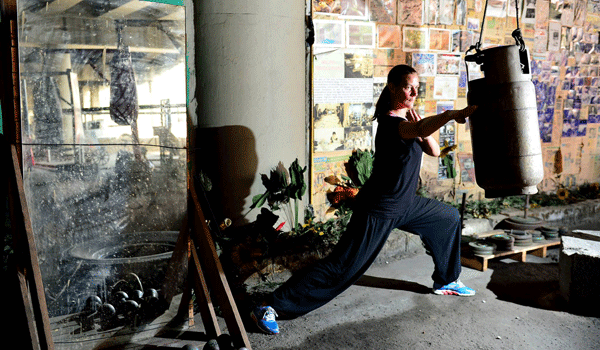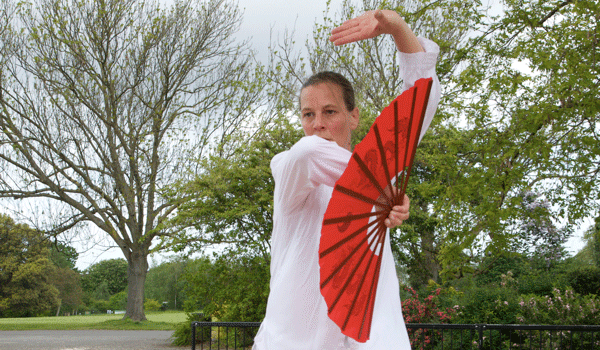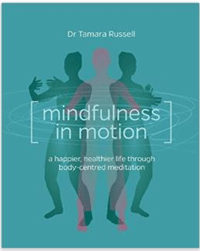[Photo: Tamara training in T’ai chi]
Anyone following what Time magazine last year called The Mindful Revolution, will have watched the movement continue to flourish with little sign of fading. Its journey has been epic – from 5th Century Zen Buddhisim to modern day secular use in health settings, education, the Arts, and performance enhancing for the likes of the US Marine Corps, Google Executives and Olympic atheletes and more. You’ve read it all before. So, what next? Questions of integrity and ethics are now being asked. Misconceptions are rife in the press. It gets political. All the while, it quietly evolves…
It’s been a year since The Art of Mindfulness launched (a not for profit project inspiring mindfulness in everyday life through a creative program of secular courses, workshops and live events), and since we first spoke to its leading expert Dr Tamara Russell – neuroscientist, author, clinical psychologist, martial artist and pioneering mindfulness trainer. Tamara’s approach to mindfulness is based on the Kung fu principle of ‘training in everything you do’. What’s clever about this, is it’s very accessible – a way of easily integrating it into everyday life. Here’s one way mindfulness is evolving.
Tamara’s new book Mindfulness in Motion: Unlock the Secrets of Mindfulness in Motion (Watkins Publishing) explains her unique methodology and is an essential guide for anyone taking up mindfulness, or looking to develop their own practice. Here we catch up with Tamara to discover more about her work, how to find a good course and trainer, and her take on mindfulness and the arts, ethics, press, and politics.
Run Riot: How has the ‘Mindful Revolution’ evolved in the last year, has it reached its zenith?
Tamara Russell: I believe it will continue to grow and this is a concept that is at the heart of mindfulness itself – continual evolution and change. The Buddha adapted his teachings for the settings in which he found himself in order to maximise engagement and understanding – similarly, in today’s modern world we need to do the same.
Mindfulness is gaining popularity and establishing itself in more and more sectors of society – from Arts and Education to the Corporate sector and the Houses of Parliament. This July (2015) it was hugely encouraging to hear that the Wellcome Trust are investing £6.5 million into a 7-year research project investigating the benefits of mindfulness in schools. Within the private sector, mindfulness seminars are increasing – often looking at bettering the wellbeing of the workforce and mindfulness of senior staff, no bad thing. For those interested, I’ll be speaking at Mind and Matter 2015 (December) – looking at exactly this: Mindfulness at Work.
What’s great about this expansion is that it asks us to really think carefully about the settings in which the mindfulness training is delivered, by whom and with what intention. There’s lots of room for creativity and development – but it needs to be done in a thoughtful way.
RR: We’ve already name-dropped the front cover of Time magazine. Quite a contrast to this Daily Mail headline: ‘The dark side of meditation and mindfulness: Treatment can trigger mania, depression and psychosis’. This begs the myth-busting question – what are the most common misconceptions the mainstream press have claimed?
TR: I will be discussing this very issue of misconceptions at the Battle of Ideas (Barbican, 17 October) as there are a variety of opinions! In many ways it depends on how ‘deep’ you want to go with the practice.
It is worth acknowledging that mindfulness may not be for everyone, however it is also important not to be overly cautious or fall prey to scare-mongering headlines.
A common misconception is that it is relaxing. Although relaxation can be a happy side effect, this is not always the case. If we look at the secular definition of mindfulness (paying attention, on purpose, moment by moment and without judgement) we can see that cognitively the mind is very active when we are practicing mindfulness. What people sometimes label as relaxation in mindfulness is actually the relief that comes from taming and calming the mind and minimising the mental proliferation that habitually occurs. This is not the same as ‘making the mind blank’ or ‘having no thoughts’.
If you’re curious, my advice is simply to find your own way. Start slowly and gently with a practice, attend a taster session, or talk to those who have done the practice. This way you will discover if Mindfulness is for you.
RR: Is there a tension between secular mindfulness and its zen Buddhist origins, over ethics and authenticity?
TR: As mindfulness has moved from the monastic setting into mainstream society there are lots of questions being raised in relation to integrity and ethics. Of course, who is delivering the teaching is a key factor.
There is an interest to develop secular teachers to deliver mindfulness in schools, hospitals and business settings. However, these teachers have engaged in the training with their own motivations and intentions and these may not always be in line with what’s at the heart of traditional teachings, namely compassion – reducing the suffering of all beings.
There is also an ethical issue about how to support those individuals who wish to travel along a secular path – particularly those who have completed a short training course but wish to go further.
A key theme at the Mindfulness in Society conference (aimed at mindfulness teachers) was how to preserve the integrity of the teaching. This was addressed through a day of guided practice from the keynote speaker Saki Santorelli who invited the teachers to really ‘walk the walk’, going deeply into their own vulnerabilities and directly experiencing their own suffering. How can we ask our students to do that if we are not willing to go there ourselves?
RR: What advice would you give to someone trying to find a good mindfulness trainer or course?
TR: The ways in which we connect with mindfulness these days are many and varied. Ideally, talk to participants – get their take on the trainer.
You might find an excellent trainer or course in a local Buddhist centre, health centre, or someone working as an independent practitioner.
It is also helpful to go to a taster session to get a sense of the trainer and see how you feel in their class. I would recommend training in a group rather than doing this independently. This way you’ll get the real experience of discovering what our minds are like – and the understanding that even though what we think and worry about is totally unique, the way we engage with our thoughts is remarkably similar!
Another tip is to check whether they meet the Good Practice Guidelines for Mindfulness trainers – or, take a look on the Mental Health Foundation’s mindfulness trainer finder website (anyone listed will have been screened).
For me, the most important thing is that the trainer is having some form of supervision and a regular personal practice. This at least means they have a more senior practitioner to bounce ideas off, helping them should they become stuck or unsure about something. You might also want to observe if the trainer really embodies the core mindfulness principles of compassion and gentleness. How do they live their lives? How do they meet their challenges? How do they convey this acceptance and openness in each and every interaction with their students? Remember, we are not asking them to be perfect, in fact it’s most helpful to see how they act when things go really wrong – this is the true test of mindfulness!
RR: Could you explain more about the evolution of ‘secular’ Mindfulness beyond the traditional MBSR/MBCT courses?
TR: My approach is very much based on the Kung fu principle of ‘training in everything you do’ – finding your own way to build the practice into your life in a meaningful way. This is different to being instructed or invited to complete certain practices in a specific order. I think different temperaments are suited to different methods of teaching, so my suggestion is to keep exploring with an open mind.
However, we do have strong evidence for the efficacy of two mindfulness training programs, MBSR (Mindfulness Based Stress Reduction) and MBCT (Mindfulness Based Cognitive Therapy). It’s worth bearing in mind these programs were originally designed for individuals in the clinical setting – to help those with a chronic pain and recurrent depression. As the mindset of an individual with a chronic or long standing condition is rather different from that of a healthy individual, it is natural that other training approaches are cropping up with modifications in the teaching methodology (including my own program).
There is much more scope to be creative with the teaching methods to ensure that as many people as possible can benefit from mindfulness training.
In my experience, a barrier to many people is the requirement on some courses to practice for 45-minutes a day over the 8-week or 6-week training. For someone with a long-standing pain condition preventing them from working, this level of commitment may be a high priority. However, for a busy professional, this requirement may seem impossible. We also find that while people try to do this practice when they are in the group, once it ends, very few of them continue. The most popular exercise after the training is the ‘3-minute breathing space’ (a short meditation) – quite different from a 45-minute meditation!
The difference in personal motivation and intention is at the heart of my training program. I want to develop internal motivation in the individual, starting them off with small steps – building a solid foundation so when the course ends they continue to practice.

[Photo: Tamara training in Kung fu. Credit: Eduardo Enomoto]
RR: Your new book, Mindfulness in Motion presents an alternative approach to mindfulness using the moving body – can you tell us more?
TR: Mindfulness in Motion draws on martial arts theory (as my own training has taken this route) to help individuals learn more about their minds through the use of the moving body.
The moving body is such a rich object in terms of the way it can help us to see some of the fundamental movements that we make in the world, and that originate in the mind. The moving body is with us all the time so we have no excuse not to practice.
The neuroscience also tells us that the processes we use to generate, modify and learn physical movements are the same processes that we use in the mental domain. An example of this is described beautifully by Matthew Lieberman whose work shows that a common brain region is engaged when we inhibit a movement, a thought or an emotion. Therefore, by working with movement inhibition, we can also strengthen the ability to inhibit thoughts or manage our emotional state.
There is emerging evidence that fundamental movements of mind rest on top of systems that control and regulate movement. For me, this is a powerful rationale to work with mindful movement. It also means that you can be exercising and moving the body at the same time as training your mindfulness – essential time-saving for busy people who may not (at least when they start their mindfulness journey) have time to sit still to practice. In my program, the invitation from the very beginning is to think about how mindfulness can fit into your life, no matter what your starting point (and it is really different for everyone!).
The program is 5-weeks as we explore five themes, but the understanding and continuing practice develops well beyond that time frame. How long does a mindfulness training need to be? is a question I am often asked and there are many variables that contribute to this including the motivation and intention of the student and the experience of the teacher.
I am happy if someone is able to report that they are doing something different as a result of the training, they have made a real change in their behaviour that leads them in a more positive direction that is more in line with their values. It is from these small beginnings that lasting changes can arise.
RR: In 2014, 70 politicians formed The Mindfulness All-Party Parliamentary group. What can we expect from it?
TR: The group set up the Mindfulness Initiative, with its purpose being to really delve into the issues associated with bringing mindfulness into education, health, criminal justice and the workplace, as well as how to increase the number of quality Mindfulness teachers out there.
As this is a new endeavour there are many unanswered questions. They’ll really need to think about the best approach to deliver quality mindfulness to the largest number of individuals in a safe way, ensuring the most efficacious outcomes.
Unfortunately there was a brief delay with the work as Chris Ruane, the MP who was taking the lead was not re-elected in the 2015 Elections. Thankfully, during May they appointed a new Director – Jamie Bristow. An interim report was published in January, and the final report titled Mindful Nation UK will be published this October (2015). For anyone interested in how the future of integrating Mindfulness into society might be mapped out, this’ll make an interesting read.
RR: Through your work, have you found Mindfulness and the Arts to be natural bedfellows – if so, how?
TR: Working with the creative industries and the Arts has been an amazing experience and I am keen to continue exploring this field. There are many creative activities that engender a mindful mode, as they rely on a deep embodied connection with an emotional experience in the present moment.
Over the last year I have been exploring a number of creative collaborations with workshops at The Vaults Festival with Artful Badger, events at Wilderness, Secret Garden Party, Latitude and the NOW Festival, plus a workshop at the National Gallery. These events have been a chance to not only talk about mindfulness to a wider audience but also to hear about the different ways that people recognize how mindfulness relates to their own creative practice. Most often what I hear is “I am doing something a bit like that but I just didn’t have a name for it”.
RR: Looking ahead – what’s really getting you excited about the evolution of Mindfulness?
TR: I continue to be excited about the possibilities for bringing mindfulness to wider audiences via increasingly creative means. I think the forthcoming production Lost In Thought, the worlds first mindfulness opera from composer Rolf Hind, produced by the Barbican and the Mahogany Opera Group is a positively inspiring sign of the times. I’m loving the idea of creative, immersive mindfulness experiences.
My work with The Art of Mindfulness has been running for 1-year now, and we continue to develop our program of courses, workshops and events – with plenty to be looking forward to. We have our next 5-week training course starting in a few weeks time (24 Sept) at the Freeword Centre in Farringdon. On 6 October we’ll be presenting a talk ‘What is The Art of Mindfulness – An Introduction to Mindfulness’ supported by Culture at King’s College London – taking place in their ‘Anatomy Museum’. Then on 7 November we’ll be running our ‘Mindful Movement’ workshop at Siobhan Davies Studios – this will explore some of the practical methods I talk about in my book.
I have also been experimenting in a number of settings with movement and enacted ways of learning about mindfulness, running what I have called ‘The Nostril Monologues’ with dancers, the general public, mindfulness students and teachers. In this enactive learning experience, we learn about the key cognitive features of mindfulness of the breath through enacted methods. I am working with a creative team now to continue to develop this and hope to have a performance piece ready some time next year.
Dr. Tamara Russell
Mindfulness in Motion: Unlock the Secrets of Mindfulness in Motion (Watkins Publishing)
Available at all good book shops (17 Sept 2015) and online (pre-order now)
The Art of Mindfulness
Join the mailing list for the latest details on Courses, Workshops and Events
www.artofmindfulness.org
facebook.com/artofmindfulnesspage
@ArtMindfulness
The Art of Mindfulness 5-week course with Dr Tamara Russell
6.30-9pm, 26 Jan – 23 Feb 2016 (Tuesday evenings)
Free Word Centre, 60 Farringdon Rd, London EC1R 3GA
Info and booking: www.eventbrite.co.uk
‘What is The Art of Mindfulness: An introduction to Mindfulness’
7-9pm, Tuesday, 6 October
Anatomy Museum, Kings College, Strand Campus, London WC2R 2LS
Info and booking: www.eventbrite.co.uk

